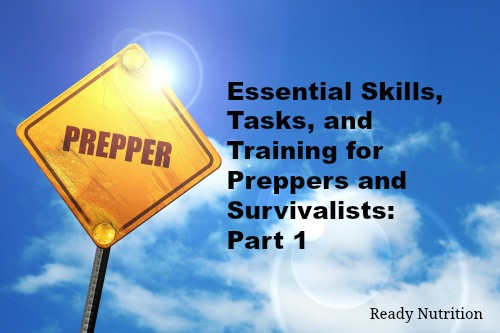
What is your focus? What type of work do you do? How do you allocate your time? A short time ago, I wrote a piece on the importance of self-analysis: creating a true picture of yourself, your strengths, and areas that you need to improve in. This holds true here, as you identify and prioritize your goals, with an overall objective in mind. Here is an overall objective for you:
To survive and thrive as you and your family develop physically, mentally, and spiritually to well-round yourselves and prepare for any disaster that arises.
Simple enough. The Mission-Essential Task List for Training can become a big part in actually realizing that objective and maintaining it. This METL (called “Metal” in the Army) for your use will use broad categories to train and prepare that you can refine as your needs change and your skills improve. Let’s start it off!
- Physical Training: It all starts here, with whatever you do to be able to “hang with the big dogs!” Whether you’re a Triathlete, a weightlifter, a boxer, or a swimmer, you need to take your personal forte and tailor it to the maximum productive capacity. Outline your training schedule, plan short and long-term goals for improvement, and take copious notes! If you’re a swimmer, do you want to swim the English Channel? If you’re a marathon runner, do you want to set a personal record for yourself? Want to “up your max” on the bench press by 50 lbs.? Part of your training is to identify your goals, and work up to them. Tie in what you can do with the tasks you will need to accomplish as a survivor. This also has to do with your overall body fat content (what is your goal?) and your measurements of weight, and tape. Physical training is not an accessory: it is a priority!
- Martial/Fighting Arts Training: this is in the form of self-defense, such as Karate or the Martial Arts, or Boxing. This also takes the form of skill with weapons and firearms. We’re talking about combat with knives, with a staff, with PR-24’s or batons. We’re mentioning rifle and pistol marksmanship and proficiency with every aspect of them…field stripping and cleaning, small repairs, maintenance, zeroing those weapons and scopes…the whole picture. Your gym should also have a heavy bag (as mentioned in past articles). You should have a definitive training plan with goals to meet. An example could be to go a whole 3-round “bout” against your heavy bag, with 3-minute rounds and 30 seconds of rest in between. An example with firearms could be to pick up any weapon…disassemble it blindfolded, identify the component parts and parts groups, reassemble it, perform functions check, and then drop the blindfold and put three rounds in the bull at 25 meters (75 feet) with iron sights at a one-inch shot group. Sound tough? High goals will yield high performance. You can do it.
- New Skills: Work on one per 2 weeks or one per month. Whatever you can handle. Electricity, mechanics, home canning, medicine. Take your pick. Give yourself courses of instruction both on your own and with someone if possible. You can never study enough, and as mentioned earlier, a good training calendar will really help you iron out the rough spots.
- Cross-Training the Family: Many people concentrate so much on individual tasks and studies that they neglect the group. The training for a group and preparation can be just as important to you as an individual. If you are the leader of your group and/or family, it will make your job that much easier if you know that your family members know what to do in an emergency and can help you.
- Book Learnin’! Yes indeed, Study: You need to well-round yourself and also to concentrate on the specifics of your specialties. Know those ballistic tables for your reloading of your firearms…and know them cold. Attention to detail. Get the rest of the family involved. Study to show yourself approved, a workman worthy of his craft. Your goal is to survive. You need to study and become a professional in all of these areas.
- Tying in the tasks and Practicum: Yes, outlining all of the functions of the family’s training and preparation…and then you need to come up with a realistic and safe training exercise for yourself. Regularly. This doesn’t necessarily mean under “ideal” or “Holly Hobby” conditions…but when it’s raining outside, and 40 degrees, and getting dark. The more realistic you make your training, the more effective you’ll be when the time comes to do it for “real.”
- Meditation and Faith: whatever it is that you follow after, make it a core of your activities. Learn to develop inner peace and strength by rooting yourself in whatever you follow after. Be the best that you can be, and face life without fear in your heart and the courage to face it head-on.
These are general categories for you to follow: essential skills, essential tasks, and essential training. You can refine them with time and practice. Weigh your priorities, and honestly assess yourself and your abilities. You will see improvement in areas only if you take action in those areas. Part 2 will cover the actual “tasks” that you need to focus on (METL) when the “S” hits the fan. JJ out!

I guess it would be easier for this 63-year-old to out think those I can’t out shoot. I wouldn’t be any challenge for Jack LaLanne.